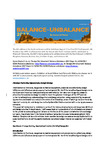'Design/Art Uncertain' Balance Unbalance 2017 Paper 8-/-0/20178-/-0/2017balance unbalance: http://balance-unbalance2017.org
| dc.contributor.author | quinn davis, pete | |
| dc.date.accessioned | 2022-04-27T10:53:08Z | |
| dc.date.available | 2022-04-27T10:53:08Z | |
| dc.date.issued | 2017-08 | |
| dc.identifier.uri | http://hdl.handle.net/10026.1/19083 | |
| dc.description | The aim of this paper is to explore the idea that design can be a catalyst for fundamental/sustainable change and that designers can provide imaginative solutions to the questions surrounding sustainability and the integration of business and the corporate world. Every day new solutions are being found to ensure our survival; but it is more than survival it is about evolution and growth not only in terms of economy but also in terms of us as human beings trying to understanding our development. Design, inventions, realisations, however you describe it, are endevouring to benefit all humanity, this paper will seek to show a few alternative ideas while focusing more on root and branch change for our communities, in education, business and design. | |
| dc.description.abstract |
The aim of this paper is to explore the idea that design can be a catalyst for fundamental/sustainable change and that designers can provide imaginative solutions to the questions surrounding sustainability and the integration of business and the corporate world. Every day new solutions are being found to ensure our survival; but it is more than survival it is about evolution and growth not only in terms of economy but also in terms of us as human beings trying to understanding our development. Design, inventions, realisations, however you describe it, are endevouring to benefit all humanity, this paper will seek to show a few alternative ideas while focusing more on root and branch change for our communities, in education, business and design. Design really does Matter: Good design works on many levels, functionally, rationally, and aesthetically. It is pleasing to use, to look at and at its best, it makes life easier, safer, slower, faster, it can be amusing, it enhances the experience of the built environment, we all take this as a given in the developed world. Designers are the world’s great intermediaries, bridging the gap between ideas and actuality. Almost everything we touch, hold, smell, sit on, sleep in, listen to or look at has been designed for us. The list is endless. Design is present in almost every aspect of our lives and we consequently take it for granted. We only become aware of design when it is ineffectual or obstructive, annoying, dysfunctional, awkward or unattractive. Global developments and an accompanying increase in related ecological and social problems are creating new challenges for designers. They are dealing with conflicts, ambiguities, difficulties and diverging requirements. Their job is not to ignore certain aspects or to compromise, but to be innovative risk takers in their quest to find solutions. A global revolution in design thinking and a more holistic approach to design education and research could provide imaginative and far-reaching solutions to the issues we are faced with in a rapidly changing world. The premise is that design is being challenged to redefine itself and that designers must assume new roles and commit themselves to developing solutions in order to secure a sustainable future. Good design has the power to connect people emotionally, psychologically, rationally, and scientifically. That is why it is ideally placed to play a leading role in reshaping our understanding of how we will move forward realistically into the 21st century. | |
| dc.language.iso | en | |
| dc.publisher | balance unbalance | |
| dc.rights | Attribution-NonCommercial-ShareAlike 4.0 International | |
| dc.rights.uri | http://creativecommons.org/licenses/by-nc-sa/4.0/ | |
| dc.title | 'Design/Art Uncertain' Balance Unbalance 2017 Paper 8-/-0/20178-/-0/2017balance unbalance: http://balance-unbalance2017.org | |
| dc.type | conference | |
| plymouth.author-url | http://balance-unbalance2017.org/ | |
| plymouth.date-start | 2017-08 | |
| plymouth.date-finish | 2017-08 | |
| plymouth.conference-name | 'Design/Art Uncertain' Balance Unbalance 2017 Paper 8-/-0/20178-/-0/2017balance unbalance: http://balance-unbalance2017.org | |
| plymouth.publication-status | Published | |
| plymouth.journal | http://balance-unbalance2017.org/ | |
| plymouth.organisational-group | /Plymouth | |
| plymouth.organisational-group | /Plymouth/Faculty of Arts, Humanities and Business | |
| plymouth.organisational-group | /Plymouth/Faculty of Arts, Humanities and Business/School of Art, Design and Architecture | |
| plymouth.organisational-group | /Plymouth/REF 2021 Researchers by UoA | |
| plymouth.organisational-group | /Plymouth/REF 2021 Researchers by UoA/UoA32 Art and Design: History, Practice and Theory | |
| plymouth.organisational-group | /Plymouth/Users by role | |
| plymouth.organisational-group | /Plymouth/Users by role/Academics | |
| dc.publisher.place | Paper | |
| dcterms.dateAccepted | 2017-08-20 | |
| dc.rights.embargoperiod | Not known | |
| rioxxterms.licenseref.uri | http://creativecommons.org/licenses/by-nc-sa/4.0/ | |
| rioxxterms.type | Conference Paper/Proceeding/Abstract |



